
by Lucas Joel Tuesday, December 29, 2015
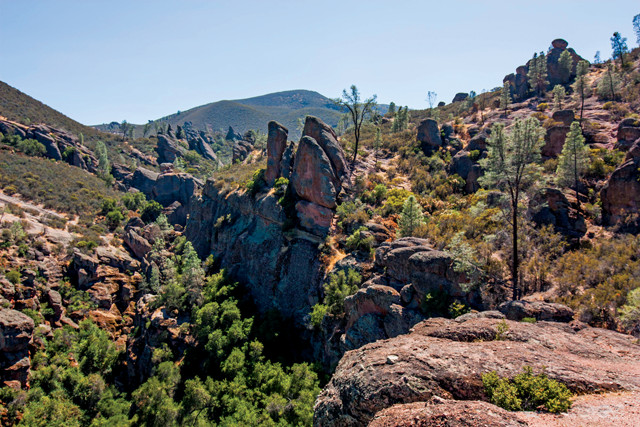
Pinnacles National Park is famous for its volcanic rock spires. Credit: Lucas Joel.
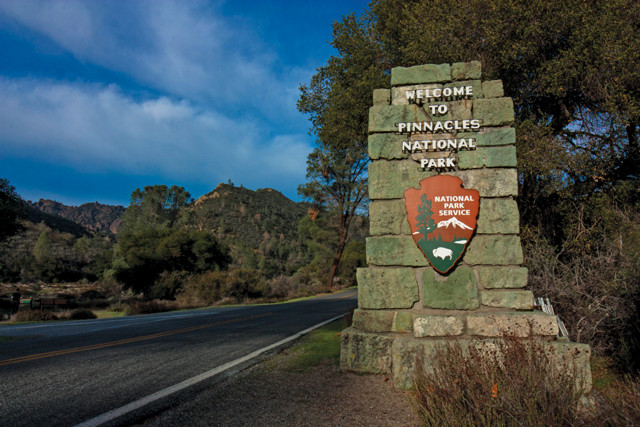
The new entrance sign on Pinnacles National Park's eastern side. Credit: Lucas Joel.
On Jan. 10, 2013, when President Barack Obama signed legislation granting national park status to the former Pinnacles National Monument — designated as such by President Theodore Roosevelt in 1908 — the land became the country’s 59th national park. Tucked away in California’s Coast Ranges about an hour’s drive inland from Big Sur, Pinnacles covers almost 11,000 hectares of wilderness near Paicines, Calif., and is one of the main refuges for the critically endangered California condor, which nearly went extinct in the 1980s. Recently, with conservation programs like the one that exists at Pinnacles, the birds are on their way toward recovery.
A trip to Pinnacles involves driving through the Coast Ranges’ rolling hills, and possibly through Hollister, Calif. — often called “The Gateway to Pinnacles.” There are two entrances to the park: one on the park’s east side and one on its west side. (If you visit, keep in mind that the two entrances do not connect by road.) Approaching from the west, you pass old signs that read “Pinnacles National Monument.” Farther along, the hills grow steeper, and, by the time you enter the park and pass the new stone column entrance reading “Pinnacles National Park,” you can see the tall spires — all composed of volcanic rock — that give Pinnacles its name.
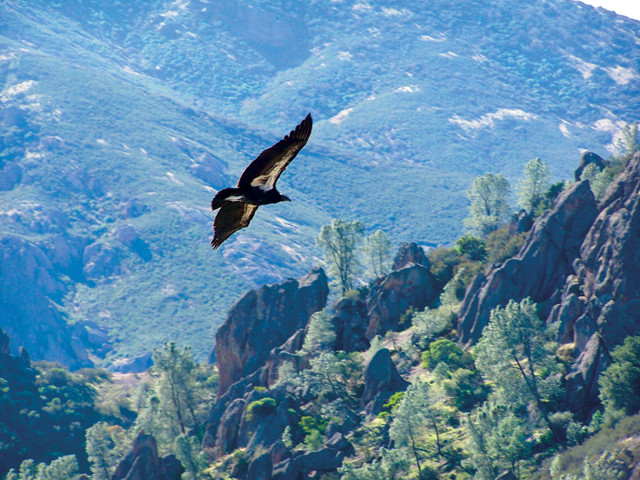
A California condor in flight in the skies above Pinnacles. Credit: NPS.
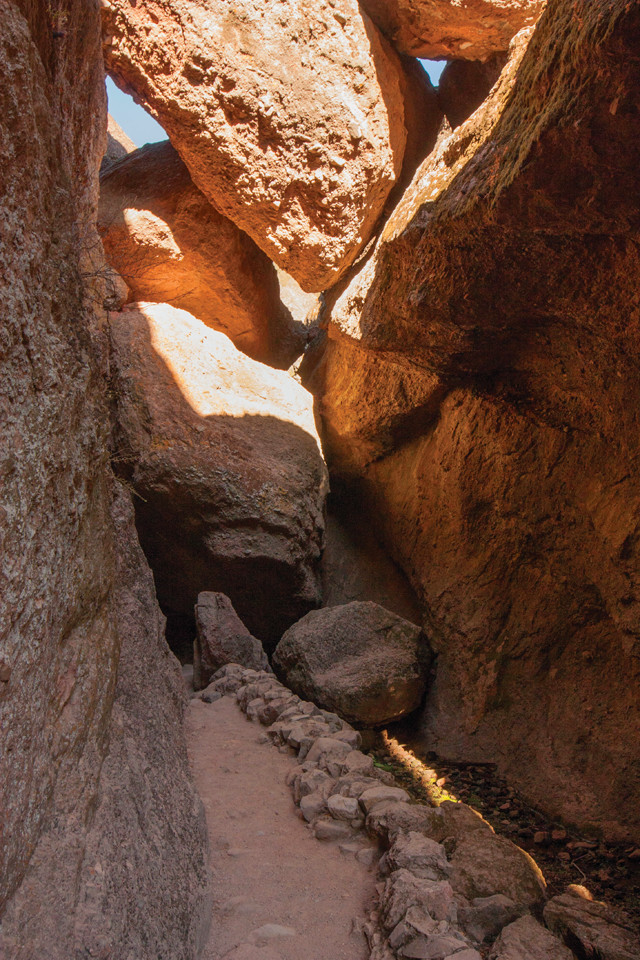
Large boulder talus near the reservoir at Pinnacles. Credit: Lucas Joel.
About 23 million years ago in the Early Miocene, subduction of the Farallon Plate under North America spurred volcanism that resulted in a 50-kilometer-wide volcanic field formed during several eruptive episodes of the Neenach Volcano. This field, composed of various volcanic rock types like rhyolite, dacite and andesite, makes up most of Pinnacles today. The volcanic mélange was further transformed by a much larger volcanic event, one that melted the preceding rocks and cemented them together, forming a rhyolite breccia.
By roughly 20 million years ago, the volcanism that built Pinnacles had ended. At about the same time, a nascent San Andreas Fault Zone — a transform boundary separating the North American Plate from the Pacific Plate — had begun splitting the volcanic field. In the last 20 million years, plate movement has continued to offset the field. Part of it is on the Pacific Plate drifting northwestward at a rate of 1.5 centimeters a year, whereas the other part sits on the North American Plate more than 300 kilometers to the south near Los Angeles. Over the years, the two parts have been subjected to different erosive regimes. “Like twins separated at birth — one dropped in the Amazon jungle, the other in Manhattan — the two formations are the same genetically but they’re very different individuals,” says Paul Lathrop, an interpretive ranger at Pinnacles. The rocks near Los Angeles form outcrops, but nothing like Pinnacles’ tall spires, which, today, provide habitat for many animals, including the critically endangered California condor. Condors like high places, like the spires, Lathrop says; a condor will lay its egg in high alcoves atop rock caves.
In the park, a trail that gives a sense of Pinnacles’ towering spires and its volcanic heritage is the Bear Gulch Trail, which begins on the park’s eastern side. Spires flank the sides of the gulch, and, toward the trail’s end, there is an above-ground talus cave made from large, boulders toppled from higher formations by earthquakes. In winter, when the reservoir at the top of the trail is full, a waterfall courses through the cave. The light-pink breccia containing pebbles and cobbles is “the volcanic version of conglomerate,” Lathrop says, which is “very climbable — it’s one of the reasons Pinnacles is also a very popular rock-climbing destination.”
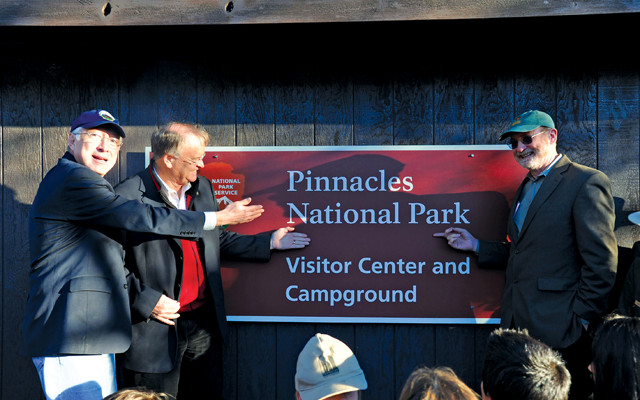
In 2013, (left to right) Secretary of the Interior Ken Salazar, U.S. Rep. Sam Farr and California Secretary for Natural Resources John Laird unveiled a new Pinnacles National Park sign at the park's commemoration ceremony. Credit: Tami Heilemann, Photographer, U.S. Department of the Interior.

A view of the reservoir at Pinnacles. Credit: Brian Thater.
Soon after Obama signed the bill that created Pinnacles National Park in 2013, a commemoration ceremony took place at the park’s east-side visitor center, during which new signs bearing the National Park Service’s arrowhead insignia were unveiled. In attendance were several dignitaries, including U.S. Rep. Sam Farr, who represents the congressional district that surrounds Pinnacles and had introduced the congressional legislation that led to the park’s creation.
Before introducing the bill in 2009, Farr consulted with documentary filmmaker Ken Burns, who had just released his multipart documentary, “The National Parks: America’s Best Idea.” Burns, who grew up in California’s Bay Area and visited Pinnacles as a child, knew the monument well and penned a letter to Congress supporting its designation as a national park.
The bill passed with strong local support; and Burns’ celebrity probably helped as well. For the park’s commemoration ceremony, Burns wrote another letter, praising the efforts of those who worked to establish the park, which will now “be preserved as Theodore Roosevelt would have wanted it, ‘for our children and our children’s children.’” Burns closed his letter with a quote from John Muir: “Happy will be [the ones] who, having the power and the love and the benevolent forecast [to create a park] will do it. They will not be forgotten. The trees and their lovers will sing their praises, and generations yet unborn will rise up and call them blessed.”
So far, the creation of Pinnacles National Park has had a positive impact on the area, says Adam Russell, the communications director for Farr. “I often say that this is the national park that saved a laundromat,” he says, referring to a nearby business that had been flagging until the park’s founding drew more tourists to the region. Increased visitation is also helping more people learn about the park’s natural resources, he says, including the condor.
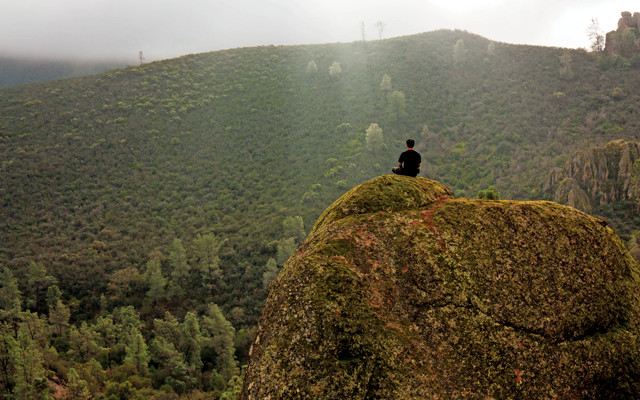
A view from the Condor Gulch Trail. Credit: Lucas Joel.
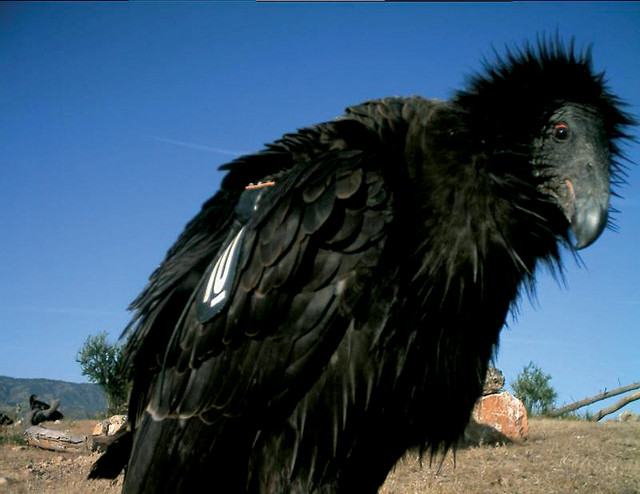
A condor checks out the "condor cam," part of the monitoring equipment used by the condor conservation program at Pinnacles National Park. Credit: NPS.
The California condor is a large bird — its black- and white-feathered wingspan can reach up to 3 meters in length. The bird does not build nests. Instead, in places like the rock cavities of Pinnacles’ spires, a condor lays a single egg directly onto rock. As scavengers, condors eat the carcasses of dead animals. When the condors consume animals that were shot and killed using lead bullets, they can suffer lead poisoning, which contributed to the species’ drastic decline just a few decades ago: By 1982, only 22 California condors were still alive.
Since then, conservation programs, like the one at Pinnacles, have helped the species slowly recover, and today there are more than 400 condors — about 230 of which live in the wild. At Pinnacles, the Condor Gulch Trail offers unobstructed views of the park and its spires. And sometimes, when the coastal fog clears, condors can be seen soaring over the chaparral and the ancient volcanic field.
But the threat to the condors is still present, says Rachel Wolstenholme, the condor program manager at Pinnacles. Many of the condors in Pinnacles travel to and from the Big Sur coastline, where they tend to roost in tall redwood trees. If the birds come across animals killed with lead bullets, “15 to 20 birds can become contaminated from that single carcass because the birds are social and may feed together at a single carcass,” Wolstenholme says. “In 2013, we lost 20 percent of Pinnacles-managed birds, and six out of seven of those deaths were due to lead poisoning.”
Wolstenholme says stopping hunting activity isn’t the solution. Rather, the goal should be to inform hunters and ranchers of the alternatives to lead-based ammunition and that choosing a nonlead alternative will have “great positive impacts not only for the condors but also for other scavengers like bald and golden eagles.”
When the National Park Service was founded a hundred years ago, Wolstenholme says, condors were common in the skies over Pinnacles and much of the region’s Coast Ranges. “I’d love for the centennial to be an opportunity for us to reach out to the public and to tell them how exciting it is that the birds are coming back.”
© 2008-2021. All rights reserved. Any copying, redistribution or retransmission of any of the contents of this service without the expressed written permission of the American Geosciences Institute is expressly prohibited. Click here for all copyright requests.